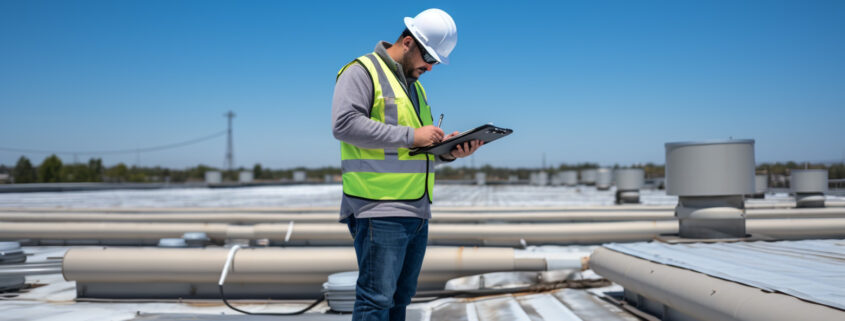Regular inspections are important if you want to maintain the health of your commercial roofing system. Building owners who skimp out on preventative maintenance often pay more down the line through costly roof repairs or even a roof replacement that could have been avoided if they’d caught the damage earlier.
To make sure you keep your roof’s condition pristine, you need to check the 9 essential pieces of this commercial roof inspection checklist. Not feeling up to the task of doing it yourself? That’s where commercial roofing professionals like the ones at TEMA Roofing come in.
Essential Elements of a Roof Inspection
A good roof inspector won’t just quickly scan your roof surface for easy-to-see signs of damage – they’ll do a thorough inspection of the whole commercial or industrial roof, and then examine several common problem areas in particular.
Here’s all that needs done to make sure that your roof condition is in tip-top shape.
1. Clean Debris
First things first, your commercial roof needs thorough cleaning. After debris is removed, you’ll get a clear view of the roof surface (because debris prevents water from flowing off your commercial building and into its drainage system). Flat roofs in particular collect a lot of debris between inspections, but even sloped roofs can collect their fair share.
Heavy objects that are on the roof too long are also one of the most common causes of roofing damage – so getting the debris cleared off regularly is important for your commercial roof’s health.
2. Identify Any Damage
Next the roof’s surface is checked for any obvious signs of damage, mildew or mold (as well as blisters in the roofing material. If you have a metal roof, it’s important to check for corrosion, as well.
3. Check for Ponding Water
An inspector looks for signs of ponding water, such as water stains or a change in roofing material color. Signs of water can be the source of more serious damage – standing water is known to cause leaks and structural damage over time.
4. Inspect the Roof Field
After looking for obvious signs of damage, the roof inspector carefully examines the field of your roof for damage that may be harder to notice. They’ll look for any punctures in your roofing material or cracks and tears in the roof’s surface. For sloped roofs, they’ll look for loose shingles.
5. Check the Parapet Walls and Termination Bar
Parapet walls and the termination bar that attaches single-ply membranes need to be checked to make sure that they are properly sealed and not cracked. This is especially important before cooler weather conditions hit. If these areas are improperly sealed, and your area experiences periods of heavy rain or snow, it can lead to serious water damage.
6. Check the Edge Materials
Likewise, all your edge materials have to be checked to make sure there’s no way for elements to penetrate your roof. If edge materials are loose, a professional roofer will need to assess if any damage has been caused as a result, and re-secure the edges.
7. Check the Gutters
Some of the major causes of standing water are clogged or damaged gutters. It’s important to clear them of debris, and check that they’re in working order. This is especially important before any seasonal rains set in.
8. Inspect Your Downspouts
Make sure that your downspouts aren’t blocked, and that they’re aligned with the gutters. If a downspout is crushed or damaged in any way, you’ll want to repair it to keep the water flowing off of your commercial roof.
9. Check Penetrations and Flashing
Any intrusions into the roof, such as skylights of HVAC machines, need to be thoroughly inspected to make sure that the roof is properly sealed at the point of penetration. You also need to check flashing details to make sure that your roof is impervious to water.
When to Get a Roof Inspection
You should get a professional roof inspection twice a year – once before the winter (in preparation for the coming weather conditions) and once in the spring (to see if any damage occurred because of snow and rain). Doing this will help you identify issues before they become a major problem.
Quality Roof Inspections Need a Quality Roofing Contractors
It’s important to hire a roofing company that will thoroughly address all the items on this commercial roof inspection checklist. They need to be experts and they need to care about the condition of your roof as much as you do.
That’s what you get when you work with TEMA Roofing. We’re commercial roofing experts who want to see you and your business succeed – while making your roof last. If you’re worried about the health of your roof, reach out to us and schedule a free consultation. When you have TEMA on your team, you can rest assured that the condition of your commercial roof is in good hands.





